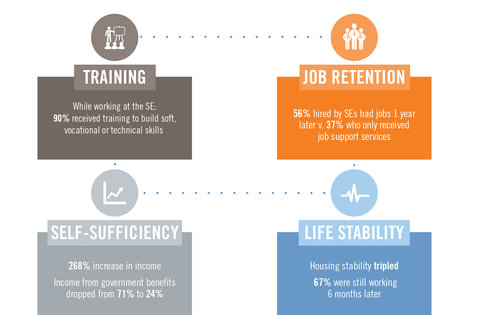We’re all aware of income inequality and the need for initiatives to address common societal issues. Yet we don’t often hear about whether programs meant to help people really solve the problems at hand, because few steps are taken to actually assess the outcomes, leaving evaluation of the initiatives to little more than a gut feeling. We’ve done the evaluation, the results are in, and the news is good!
The truth is, results are as critical for the social sector as they are for business, particularly when addressing the staggering unemployment rates that persist for millions of Americans. Even during good times, unemployment remains as high as 50 percent or more for people who have been homeless or incarcerated and young people who left school, but have not found legitimate employment. Beyond the high costs to taxpayers and families, out of work Americans are more vulnerable to life-threatening consequences.
Although our country spends billions of dollars on workforce training and development programs, we know far too little about the results. With data, we will know what to invest in, and how to improve the odds of achieving positive change. Do these programs really help people get or keep jobs, make more money or reduce reliance on public programs?
With the support of the Social Innovation Fund (SIF), REDF commissioned the internationally-known evaluation firm, Mathematica Policy Research, to study the impact of social enterprises on individuals and society. Social enterprises (SE) are mission-driven businesses, in our case focused on hiring and assisting people who face barriers to work. The population targeted through social enterprise is often overlooked, with 25 percent never holding a legitimate job prior to getting one in a social enterprise, 85 percent without stable housing, and 71 percent of their monthly income from government benefits.
The exciting news is that this first-of-its-kind report shows that this model works! People’s lives improve and society’s return on investment more than doubles. Additional key findings*, include:
1. Workers gained economic self-sufficiency one year after beginning the social enterprise experience
• Sixty-seven percent were still working six months later
• The average monthly wage and salary income increased by 268 percent
• The percent of total income from government decreased from 71 percent to 24 percent
• SE employment led to a 19 percentage point increase in employment one year later, compared to a matched group that did not get a job in social enterprise and only received program services
2. Social enterprises helped stabilize workers’ lives
• Housing stability tripled with employees living in a home or apartment throughout the year (15 percent to 53 percent
3. Post-employment supports play an important role
• 90 percent received training to build soft, vocational or technical skills
• Nearly two out of three workers reported post-SE employment supports. These initiatives led to a 21 percentage point increase in housing stability and $428 increase in total monthly income
4. With social enterprise, benefits outweigh costs
• Every $100,000 spent by the SE produces benefits worth $223,000 for society as a whole
• Taxpayers specifically gain $131,000 of these benefits for every $100,000 spent, primarily from reduced criminal activity and government transfers
• And the other $90,000 of benefits flow because via their business model – the enterprises roughly break-even, making this a cost-effective model that generates revenue to achieve a social purpose; and the employees earn wages while they receive training
Alongside these compelling outcomes, two findings challenge us to strive to do even better:
1. SE workers incur small income losses from SE employment. Worker income and life stability gains do not exceed losses from reduced government transfers and increased housing and health costs.
2. Keeping jobs is critical. While a lot of people went to work and kept jobs, with each passing month a lower percentage maintained employment.
How to address the challenges? A couple solutions:
First, social enterprises need to develop tighter bonds with mainstream employers, opening the door to next-stage employment. Additionally, competitive companies should hire these well-trained and loyal employees, offering additional training and advancement opportunities, as appropriate. Increased momentum will encourage other employers to hire more of these individuals, allowing them to retain jobs and professionally advance.
Second, we must incentivize people to work and advance through employment. Our ‘hour glass economy’ offers a large number of jobs that do not pay well. The growing trend to connect struggling workers with post-secondary school credentials that are recognized by business is critical. And government benefits and tax policies have to change. Currently, when people go to work, public support falls off a ‘cliff.’ Instead of helping people cover basic expenses like housing if work income is insufficient, public programs provide more if you don’t work at all, rather than if you hold a low-paying job. Applying the earned income tax credit to adults without custodial children — as the President, Marco Rubio and Paul Ryan all agree – is part of the solution.
We’ve got the results. We know the impact this can have in solving the social issue of chronic joblessness. Now it’s time for employers, funders, and government to double-down, make work pay and offer people who never get a chance a path into work and community. Those are results bound to get our hearts racing.
For more information on the Mathematica Jobs Study, click here: http://redf.org/jobsreport
*Homeless numbers from National Coalition for the Homeless: http://www.nationalhomeless.org/factsheets/employment.html. Incarcerated from Ex-offenders and the Labor Market, Schmitt and Warner: http://www.cepr.net/documents/publications/ex-offenders-2010-11.pdf. Young people from Opportunity Road: The promise and Challenge of American’s Forgotten Youth, Bridgeland and Milano: http://knowledgecenter.completionbydesign.org/resource/487
Carla Javits is President and CEO of REDF, an organization that is leading the pioneering effort to create jobs and employment opportunities for people facing the greatest barriers to work. Through her stewardship, REDF has helped impact the lives of thousands of people in need by investing capital and expertise in social enterprises – mission-driven businesses focused on hiring and assisting people who are willing and able to work, but have the hardest time getting a job. Inspired by REDF’s founder, George R. Roberts of KKR, Carla focuses on achieving measurable results by providing a business solution to solve chronic joblessness.



